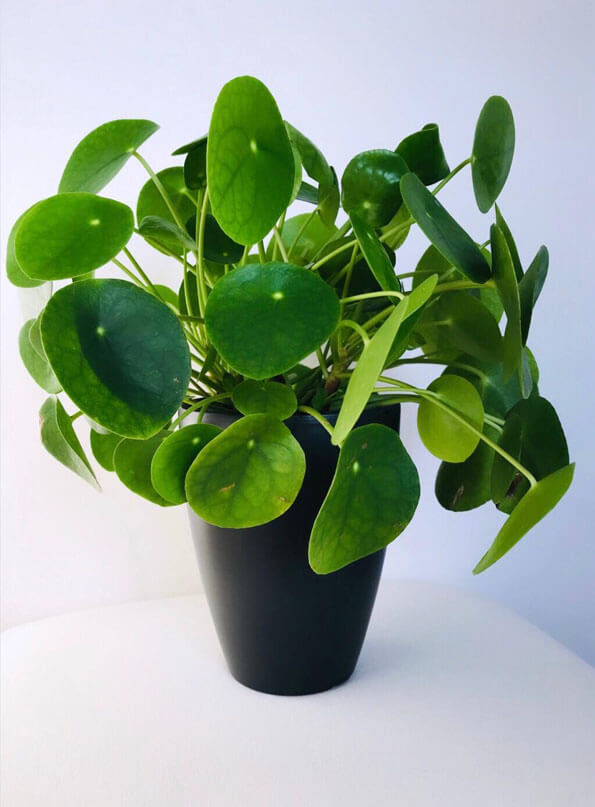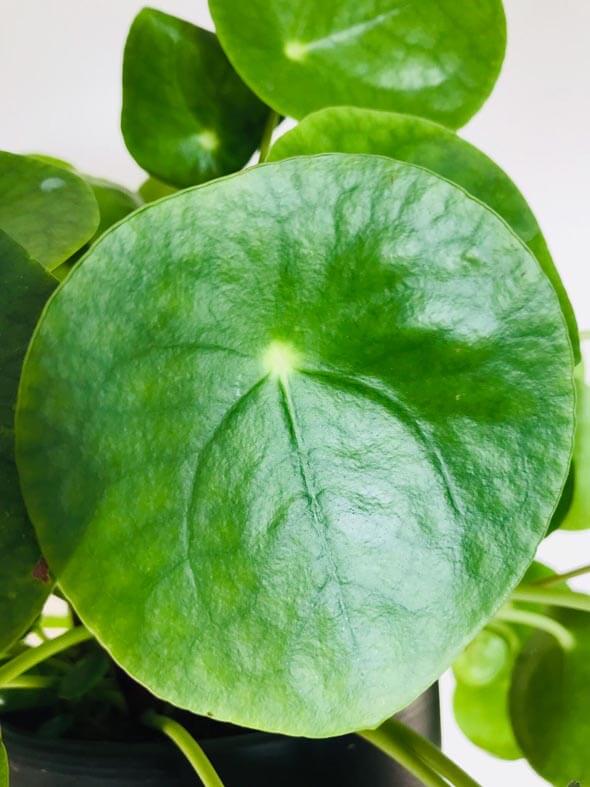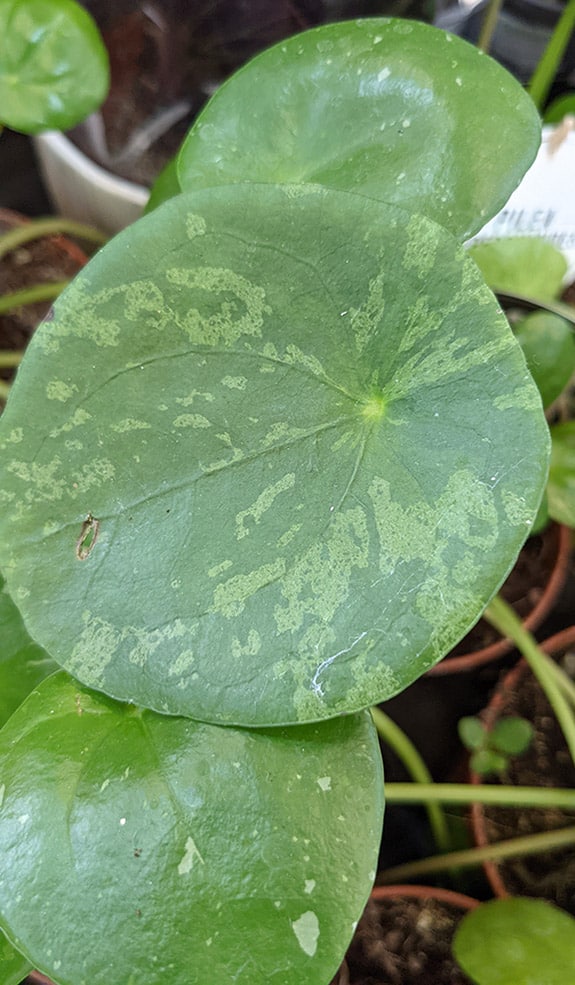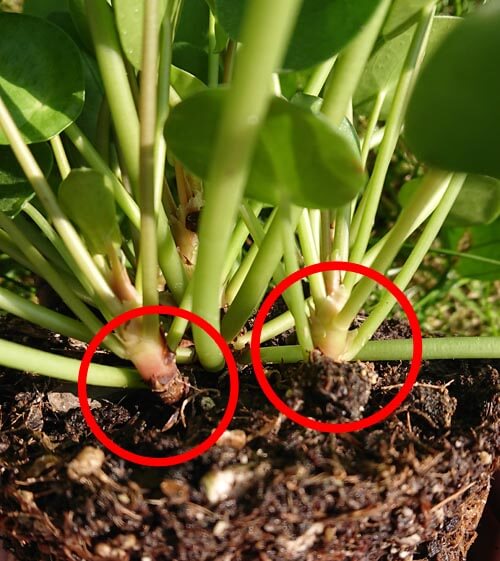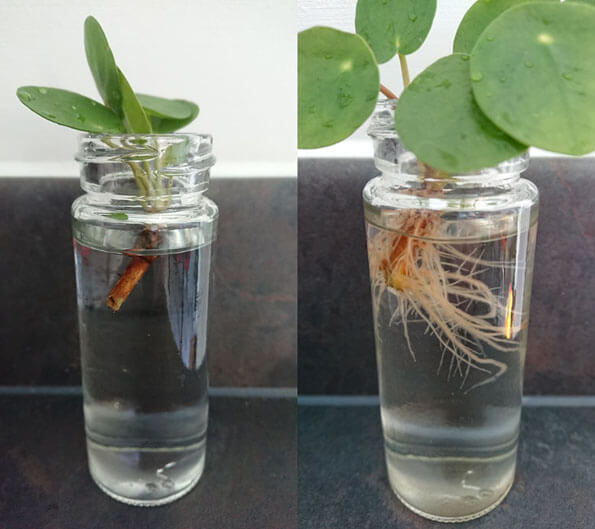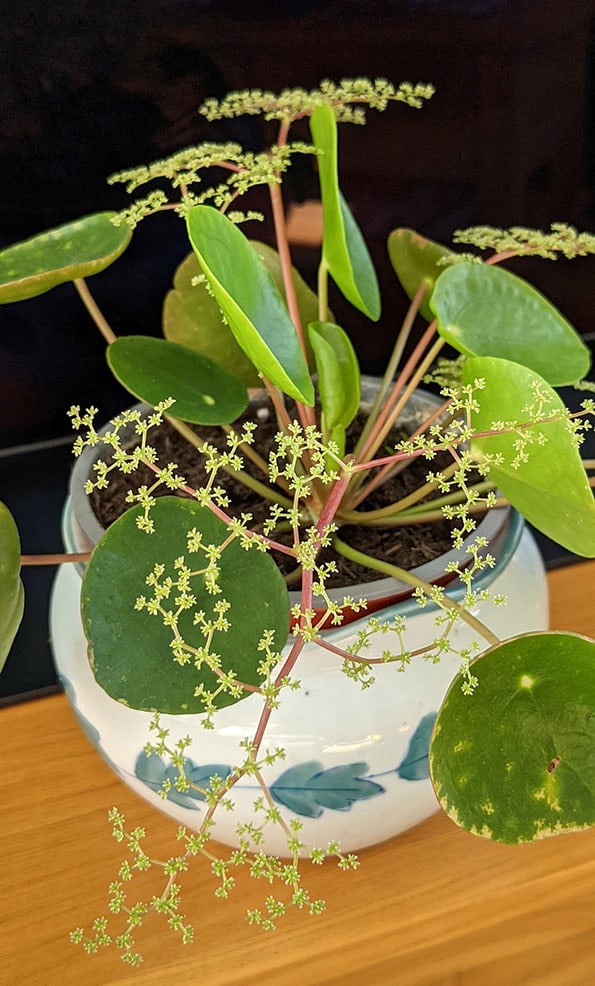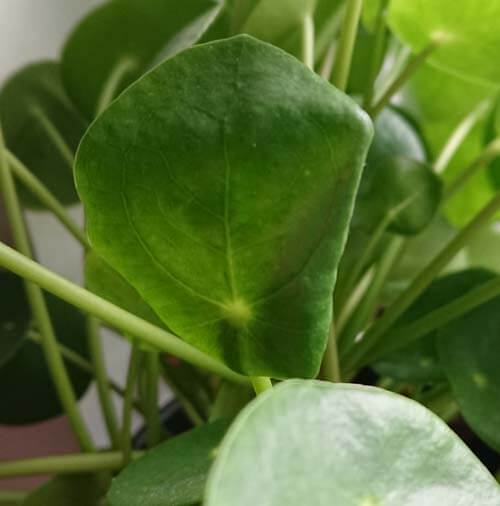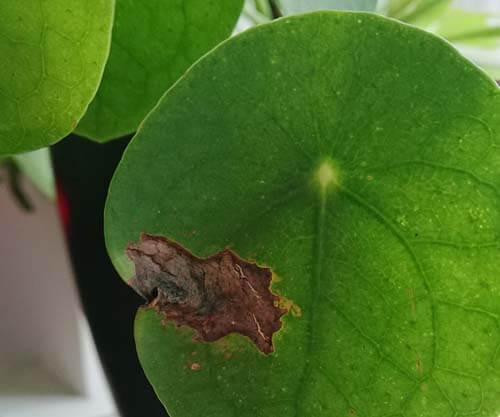Pilea peperomioides is an easy to grow modern looking houseplant. Often called the Chinese Money Plant, Pancake Plant or Missionary plant, it's straightforward to care for and simple to propagate.
Whether you're a newbie to houseplants or a seasoned expert, a Pilea peperomioides plant is sure to be a welcome addition to any indoor plant collection.
By the end of this article you'll know how to care for your Pilea plant, understand what you need to keep it strong and healthy and learn how to take cuttings to share with friends and family (it's not known as a pass-it-along plant for nothing after all!).
P. Peperomioides which also goes by the name "Chinese Money Plant" or "Pancake Plant"
It originally came from Southern China and has flat round coin shaped leaves. Together these things gave rise to it's common name of the "Chinese Money Plant".
Each of its lily pad like leaves float on dainty looking stems that will bob around independently in a gentle breeze. Towards the upper part of every leaf will be a white, or lighter shade of green, dot where the stem meets the leaf and holds it in place.
TIP - They look striking as individual plants, or next to other plants to create an attractive display. As long as you avoid shady places they will grow happily all over the home.
This houseplant was practically unheard of before 2017, and then it came out of nowhere to become one of the most popular indoor plants today. People loved it and here's why: Instagram.
Hashtags like #pileababy and #pilealovers shot what was, an uncommon houseplant to fame and in a big way. It was cute, unusual and other people wanted to own one too. They weren't the easiest to find plant either and inevitably, when something is harder to come by it's much more desirable.
How do you pronounce Pilea Peperomioides correctly? Say:
Pie-LEE-uh Pep-per-row-me-OY-dees
Even if Instagram can hands down claim it was responsible for the marketing success, the plant still has some great traits and qualities that speak for itself and should easily get you looking past the trending Hashtags.
Maybe you're just browsing our site and don't actually own one yet. Well it's reached that stage now where they're increasingly common place and easy to get hold of. This obviously varies from country to country and some people have more luck than others.
Photo showing a Pilea Peperomioides leaf. The round disc shape is why it's sometimes called "UFO Plant" or "Coin Plant" .
It's usual to find them as baby plants or in a juvenile form because this is when they're arguably the most attractive (Read: Cute) and the sellers find it easier to sell them on.
Ideally you don't want to be spending more than around $15 on a baby plant, however if there's a Pilea drought in your local area you might have to shop further afield or look online.
In most of our other houseplant profile articles, we tell you about the different varieties you can buy. However in this case, it's mainly P. Peperomioides that you'll find in the shops.
There is one other variety that I've seen and that's Pilea peperomioides 'Mojito'. Similar growth habit and appearance to the all green type, but there is variegated on the leaves. The amount of variegation you get varies between plants and it's not hugely impactful, but if you love these plants it could be worth searching for.
The rare ‘Mojito’ has pale green variegation.
In time perhaps we will start to see other cultivars, but for now it's all about the the all green and Mojito variety. Up next is the care instructions for you to follow which if you stick too will hopefully help keep your plant looking great for years.

Hi, I'm Tom!
If you're like me and enjoy the challenge of growing houseplants and getting them to thrive, then Ourhouseplants can help. This website shares my knowledge and years of growing plants and provides (hopefully) helpful advice on properly caring for your indoor plant friends.
The light requirement is one of the essential pieces of care to get correct, so spend some time here making sure you get it right. Lots of websites will tell you these plants don't like direct Sunlight, but this isn't totally true.
Look at your Pilea closely and you'll see a lot of succulent like qualities - tough waxy leaves, thick stems etc. These are all indications the plant will cope with strong bright light and even some direct sunlight. In fact they actually demand this and will suffer pretty quickly in low light conditions.
In the short term, if you don't give enough light the leaves will bend and curl rather than remaining flat and coin like. Longer term the growth will be sparse and you'll lose the "full" look.
If you happen to give too much light the leaves will gradually take on a purple hue or have a washed out appearance.
If the light level increases rapidly, for example if you've been keeping it in a low light condition and then moved it into direct sunlight, burn spots can occur. Make sure you move your plant gradually so it gets used to the changing conditions.
Don't hide your Pilea Peperomioides away from bright sunlight. They actually quite like a bit of sun! (in moderation)
Unless you're providing bright light from above, such as from an overheard skylight or grow light, they will not grow straight up. Instead, the central stem will lean towards the light source and all the leaves will start to face the window.
To prevent this, rotate your plant one quarter of a turn every week. You can actually use this trait to your advantage to create three distinctive "looks".
My plant likes to be thoroughly watered and then left alone until it almost dries out before watering again. Bear in mind if you're giving good levels are light and the temperature is reasonably warm you may need to water a few times a week. Less when it's Winter or cooler.
When things get too dry the plant tends to have a droopy look about it as the stems lose strength and everything starts to flop. Look out for your plant giving you this hint if you're usually bad at watering your houseplants!
That said, if you've overwatered, your plant may also do its drooping thing. So if you see your Pilea doing its flop, make sure you're double checking the soil before reaching for the watering can.
Most homes and workplaces will have a decent level of humidity and it's not likely something you need to be thinking about.
However your Chinese Money Plant may struggle in excessively humid locations. Mix that in with low light and cool temperatures and you have the perfect recipe for the leaves going yellow or various mold or root rot problems. This isn't the ideal houseplant for windowless bathrooms or kitchens.
Pilea Peperomioides will produce a fair amount of growth and a load of pups on a regular basis so they'll need feeding occasionally to keep everything working as expected.
But don't overdo it. Once a month using a standard houseplant or cacti based fertilizer is all it needs.
This plant needs temperatures no lower than 13°C (55°F) and it needs to be warmer than that for it to actually grow. So this translates into avoiding cold places and keep it away from any risk of frost.
These are heat loving plants, so generally speaking, the warmer it is the more growth you'll get.
These houseplants need space and will frequently outgrow their pots, either because the mother plant has grown larger, or because she has produced so many offsets that the container is full.
When we first got our baby plant it need repotting twice in the first year due to how much it grew. Once a year was enough in the following years. Make sure you don't upsize it into a giant container, just one or two sizes bigger than the previous pot is perfect.
When picking the soil for your Pilea, A standard all purpose potting mix is all these plants need
In terms of the soil that Pilea peperomioides needs, you can just use a standard all purpose potting mix. Look for one labeled as suitable for houseplants or garden plants. Good drainage is always a plus as this will help aerate the soil and give the roots space to grow and room for new pups to form.
The potting mix does need to hold a reasonable level of water as these are thirsty plants. So do yourself a favor and avoid very porous mixes otherwise you'll be watering almost daily trying to keep up with the demand.
One of the major benefits of this plant is how easy it is to propagate through cuttings and removing the constant supply of offsets and runners that it generates.
You can grow Pilea Peperomioides from seed, but this is pretty difficult. Lots of people sell seeds online, but they seem to lose vigour pretty quickly, so fresh will yield the best results. However because you don't know how long ago the seed you're buying was collected it can be hit or miss.
New plants from seed are quite slow to get going and then it takes even more time for the seedling to reach a decent size. Growing it from seed therefore doesn't really make sense unless you have no access to a mother plant from which you can harvest from.
Let's assume you've opted for the easier option and want to work with the pups. Here's how to get a load more Pilea Peperomioides going, and it's super easy.
Firstly have a look down at the type of growth you can see at the soil level of your Pilea. Once the main plant gets to a certain level of maturity you will see lots of growth points or "offsets". The main stem will be the biggest and you can either see smaller versions growing or little wooden stems with small leaves emerging.
TIP - Can't see any offsets? If you only have the main mother plant stem, then your plants not old enough yet. Give it a few months and check again.
In the photo below you can just see the main stem in the background which belongs to the mother plant. The growth points in the red circles are the offsets that it's produced and these can be removed and grown on. It's really easy to do. Trust us.
A congested Pilea plant with multiple offsets
You have two options. You can try and remove the entire offset along with its root system. However Pilea plants tend to get quite congested and with all the leaves and stems growing so close together this can be fiddly to get right.
If you're feeling confident give it a go and see how you get on. If things go wrong and you only end up with the main stem and no roots read on as you can still use what you've come away with.
The next option, is to remove / dig out a little of the soil surrounding the offset's main central stem as close to the mother plant as possible. Once you've gone as far as you can without damaging the mother plant, cut it off with a sharp knife. The photo below on the left shows the result - A good chunk of the wooden brown stem, but no roots.
Next, you just put the offset into a container of water. Make sure the stem is actually submerged but the green growth sits above the water level.
Rooting a Pilea Plant using water before and after.
In just a few short weeks you'll have a full network of new roots as shown in the photo above on the right. At this point remove it from the water container and pot up into a similar soil mix to what it was growing in previously.
It's a quick grower so the offset should root and fully anchor into the soil after another couple of weeks, at which point it's safe to give your new "Friendship Plant" away. Or allow it to take its place as a fully fledged new addition to your own houseplant Family, or as they say on Instagram #plantgang.
Can you root just a Pilea leaf and its attached stem? Yes, you absolutely can. However if you only have the stem which attaches to the leaf rather than part of the main central brown stem, then it's likely it will never develop into a normal plant. i.e. you will just have that sole leaf forever.
As you've likely gathered from reading our article so far, these plants are fairly vigorous and will grow reasonably fast.
It's hard to be accurate because you will have different growing conditions to what I have, but it's fair common to expect your plant to double in size every year. Very young plants are likely to triple in size during their first year.
Most people will want to grow their Pilea at a small to medium size. But it's obvious from the many photos out there that they can become very tall over time if you let them.
The main plant will tend not to spread out too much, but if you allow the offsets to grow in place rather than remove them, they will eventually give a fuller, wider look.
Pilea Peperomioides is grown for its cute look and unusual pancake like leaves and not for any showy blooms that it occasionally produces. But it's perfectly true that well grown and mature Pilea's will eventually give you some flowers. They're politely unremarkable and don't smell but they're still quirky in their own special Pilea way.
With maturity, good light levels and warm temperatures the Chinese Money Plant will flower quite often.
Is Pilea peperomioides safe around cats? Yes it is. It's also safe to have around dogs, children and most other pets too.
If your pet has too much interest in the leaves then you may want to move it to a new place as boisterous play can cause damage.
Your Pilea peperomioides can be grown to give three different appearances, or "looks". Below we'll look at each one and explain how to get it.
The creation of the looks is long term and once you go for one style it's quite hard to change it, so think carefully about what you're looking for. You can of course propagate a few plants and grow them all differently.
Bright Light Avoid prolonged intense midday and early afternoon sunlight as well as very dark areas.
Moderate Watering Once or twice a week in Summer and once every two weeks in Winter or if growing in lower light conditions. Will cope with a little drought, but suffers easily with excess water around the roots during winter or in low light spots.
Temperature Average room temperatures are fine. No lower than 13 °C (55°F).
Feeding Fertilise your Pilea once every month or so.
Curled Leaves / Domed Leaves
Curled leaves on a Pilea Peperomioides is a common thing to see. It's not usually a terrible problem but it will obviously draw your attention, because the leaves arguably look their best when they're flat and pancake shaped.
Usually this houseplant has flat coin-shaped leaves but this one has a problem as the leaves have curled.
They will either curl inwards (back towards the central part of the plant) or outwards (away from the plant). It can be caused by a number of things and sometimes the same thing can cause each symptom, which can make it tricky to work out what's going on. In most cases it tends to be a light issue.
Curled leaves (inwards)
Not enough Light or not watering correctly (either too much or too little).
Curled leaves (outwards)
Too much light, high temperatures or again not watering correctly (either too much or too little).
When the growing conditions have been corrected the leaves will frequently flatten out again. However, on occasion, they'll stay permanently curled / domed shaped.
Yellow Leaves
Older leaves at the base of the plant will go yellow in time. This is natural. Lots of yellowing over a short period is not. In almost all cases rapid yellowing is the result of being heavily overwatered and allowing the container to sit in water.
You can use a terracotta pot with at least one drainage hole at the bottom to help the potting mix dry out faster. If you can't do this, then think about using a free draining potting mix instead. This will prevent so much water from being held around the roots.
Sometimes yellow leaves can also be caused by not being fertilized for prolonged periods.
Brown / Black Spots (not crispy)
If small parts of the leaf have gone brown or black and the bits aren't crispy and brown, then there is a good chance it's been caused by one of the following:
Brown Leaves
If the brown is crispy and dry, occasional and covers a reasonably large area of the leaf as shown in the photo below, then it's probably sun damage.
We explained in the Pilea Care instructions above, that these plants like bright light and even some sun and this is definitely the case. However if you plonk your plant in a south facing window after it's been used to living in a dark and shady location, the leaves can easily burn.
So if you're planning on moving your plant, get it used to the new place by gradually moving it closer or putting it there for a few hours each day.
Pilea Peperomioides with a brown crispy section in the leaf
I rescued my own Pilea peperomioides from an expensive high end department store. It was being sold along with a very attractive looking container pot but was ludicrously overpriced.
Unfortunately, it was also being seriously abused with so much water pooling around its roots it looked like it was about to head off to the houseplant graveyard. I cheekily poured the water out of the container and went off to carry on browsing.
Thinking about it (and maybe feeling quite sorry for it too) as I walked around the store I decided I didn't want to leave it in the care of people who didn't know what they were doing. So I went back for it.
Fortunately, it was also heavily discounted as a result. So much so it made it worth the gamble (even if it died at least I'd have a nice container for another plant later on and you can never have too many pots right?).
Although touch and go for the first week, true to its almost indestructible nature it pulled through without any real effort from me and we've got along perfectly well ever since.
Along the way I made some mistakes (as we all do), one was too much light resulting in the brown burns you can see in the photo in the problem section. But nothing really held this plant back from settling into its new home. Before long I had a plant growing vigorously and producing multiple offsets (which I've propagated very easily).
What's been your story with this plant? Did you discover it through Instagram or somewhere else? How many new plants have you propagated and passed on? Let us know in the comments below.
(Gallery) Photo credit of the flowering Pilea - Magpie Ilya
(Gallery) Photo credit of the Pilea and ruler - Pepe-MS
(Gallery) Photo credit of the tall Pilea in the black pot - Pepe-MS
(Gallery) Photo credit of the plant in the clay pot on white saucer - Quackor
